Today’s post continues my exploration of all the plaques in the City of London, today covering Doctors Commons, St Thomas the Apostle and St. Leonard’s churches, Haberdashers Hall and the Daily Courant, the country’s first daily newspaper.
Doctors Commons
Walk along Queen Victoria Street, and to the right of one of the doors to the magnificent Faraday Building (see this post), is a blue plaque:
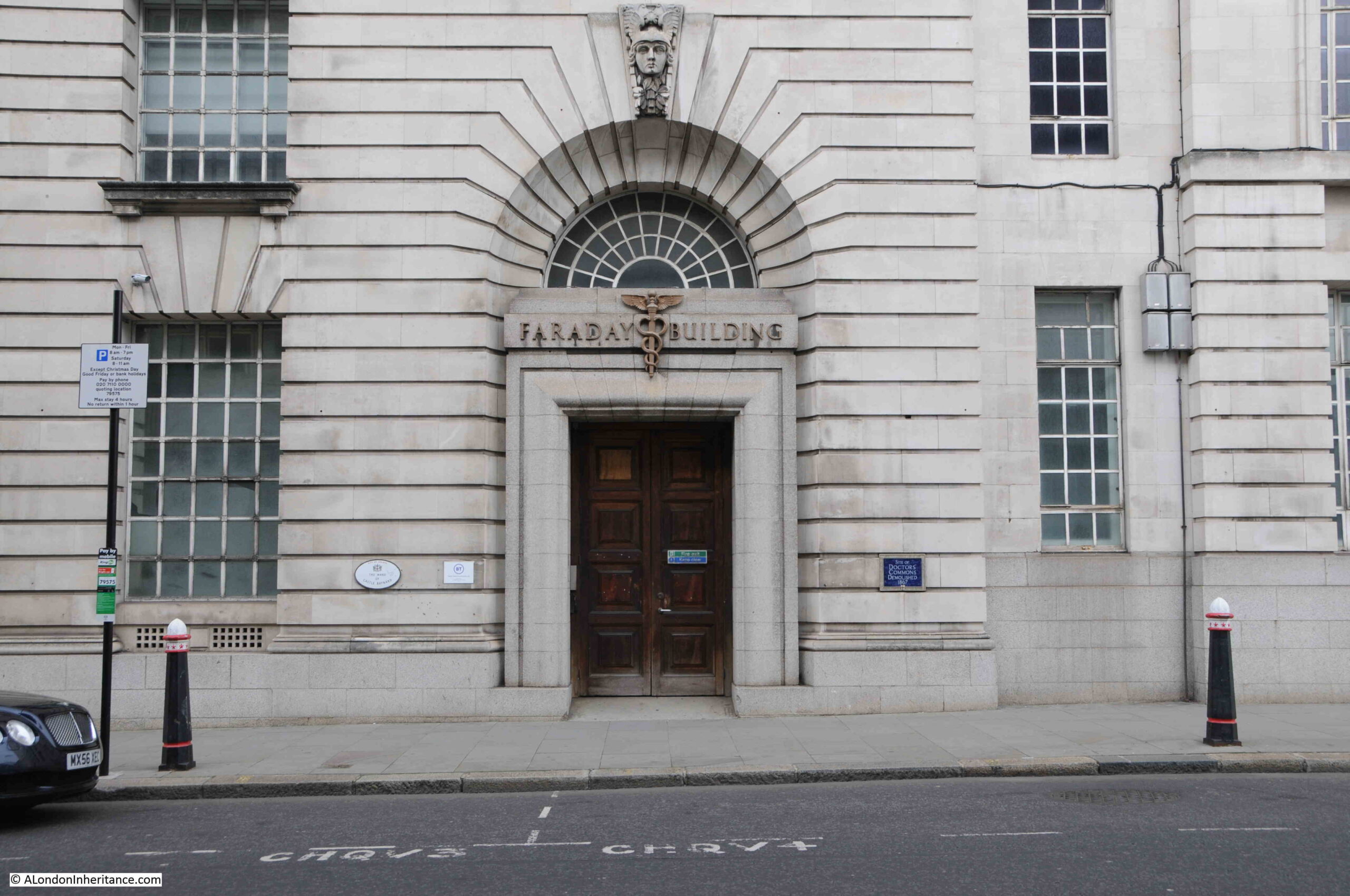
Recording that this was the site of Doctors’ Common, demolished in 1867:
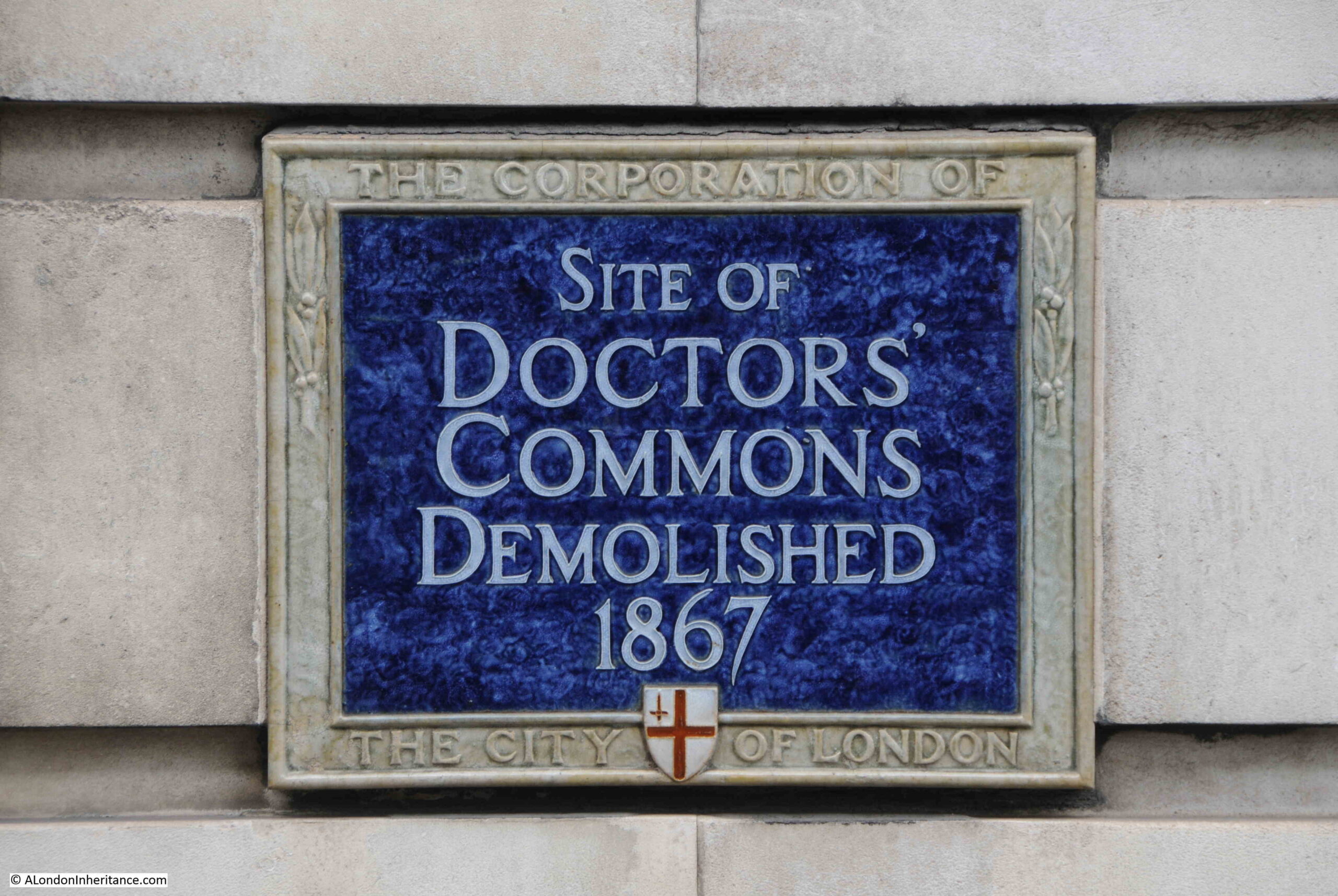
Doctors Commons was founded on the site in 1572 as the College of Advocates and Doctors of Law. The buildings housed the Ecclesiastical and Admiralty Courts, along with the advocates who practicsed within these courts,
There were a total of five courts within Doctors Commons:
- Court of Arches which was the highest court belonging to the Archbishop of Canterbury. The name comes from the arches of the original Bow Church in Cheapside which was the original location of the court.
- Court of Audience. This was another of the Archbishop’s courts, and was where the Archbishop would make a judgment on the cases that were brought to the court.
- Prerogative Court. This was the court where wills and testaments were proven.
- Court of Faculties and Dispensations. This was where special permission was granted to do something which the law would not normally allow. There are newspaper records of this court being used to allow quick marriages without the normal requirement for banns to be read in church.
- Court of Admiralty. This court belonged to the Lord High Admiral of England and is the court where matters relating to mariners, merchants, ownership of ships etc. were settled.
The accounts of the cases brought to these courts are fascinating and shed a light on the legal system of the time. One of the activities of the Court of Admiralty was to decide on the ownership of captured enemy ships, for example, in July 1744:
“Last Monday a Court of Admiralty was held at Doctors Commons, when the Santa Rosetta, a Spanish Ship, taken by the Romney, Man of War, Greenwill, was condemn’d as a legal Prize, and the Shares ordere’d to be paid to the Captors forthwith.”
And in June 1747:
“On Tuesday was held at the Court of Admiralty at Doctors Commons, when the French Ships taken by the Admirals Anson and Warren, were condemned as lawful Prizes.”
The decision that these ships were prizes seems to have been a formality as I could not find any report where the status of a prize was not the outcome. Many a ship’s captain must have come away from Doctors Common a very happy, and financially better off, person.
The plaque next to the door of Faraday House implies that Doctors Commons was specifically at that location, however it occupied a much larger area. I have outlined the area occupied by Doctors Commons in the following extract from Rocque’s map of 1746:

Queen Victoria Street had not been built when the above map was created. It was built during the 1860s and is why the plaque gives the end date of Doctors Commons as1867 (see this post for the story of Queen Victoria Street). To get an idea of the route of Queen Victoria Street, the College of Arms can be seen to the right of the above map, and this now sits on the northern side of Queen Victoria Street, so the street ran along the southern edge of the College of Arms, down to the left where it met Thames Street.
Doctors Commons was mentioned by Charles Dickens in David Copperfield and the Pickwick Papers, and it seems to have been the type of place where the intricacies of the law, were often dragged out, and mainly to the benefit of the legal profession at the time.
The Prerogative Court dealt with wills and probate, and before its closure, was recorded as having a vast store of wills, including those of Sir Isaac Newton and Inigo Jones. This store also included a will written on a bed post, which was presumably a will written in the very last moments of life.
The following print shows the Prerogative Office in Doctors Commons in 1831, This office is marked in Rocque’s map, in the top left of the extract I have shown above (© The Trustees of the British Museum).
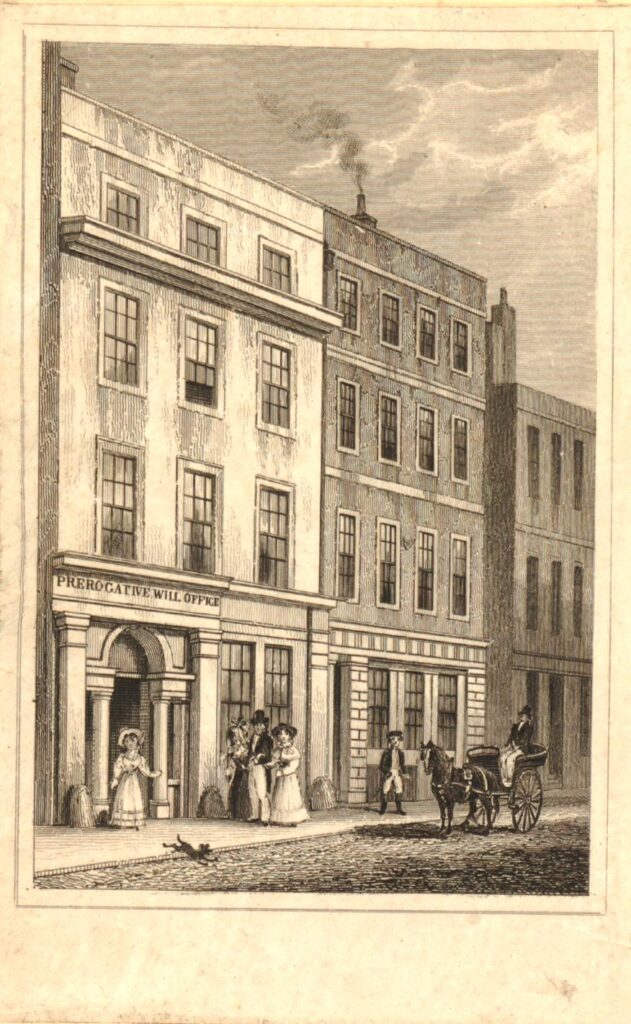
By the time of demolition, many of the buildings of Doctors Commons had fallen into disrepair. Various acts of Parliament had changed the way that legal matters were dealt with, and the Court of Probate Act and Matrimonial Causes Act, both in 1857, along with the High Court of Admiralty Act of 1859 ended the majority of legal work at Doctors Commons.
The land was sold off and rebuilt. The southern tip of the area was incorporated into Queen Victoria Street, and this old legal area was reduced to a blue plaque.
St. Thomas the Apostle Church
The next plaque is to one of the many City churches that were destroyed during the 1666 Great Fire of London and were not rebuilt. The plaque is on a low wall on the corner of Great St. Thomas Apostle:

Next to the street name sign:

I cannot find any prints of this church, and there is little information available. My source for all pre-Great Fire churches is Wilberforce Jenkins “London Churches Before The Great Fire” (1917), and he writes about the church:
“The Church of St Thomas Apostle was in Knight Rider Street, at the east end of the street where the modern Queen Street crossed. from the earliest times it belonged to the canons of St. Paul, and is mentioned in the register of the Dean and Chapter in 1181. William de Sleford was priest in 1365 and William Stone was chaplain in 1369, being appointed by the Archbishop of Canterbury.
And yet the Dean and Chapter of St. Paul’s presented William Brykelampton in 1415. The church would appear to have been rebuilt before this date, for Stow tells us that ‘John Barnes Mayor in 1371 was a great builder of St. Thomas Apostle parish church as appeareth by his arms there both in stone and glasse’. the same John Barnes left a chest and 1000 marks, to be lent to young men ‘upon sufficient pawne, and for use thereof”.
John Barnes was the Lord Mayor at the time, which probably explains why he had his arms inscribed on the stone and glass of the church.
The church has long gone, but the street name and plaque records that it was here.
St. Leonard’s Church
In Foster Lane, between the ground and first floors of a modern building is a plaque:
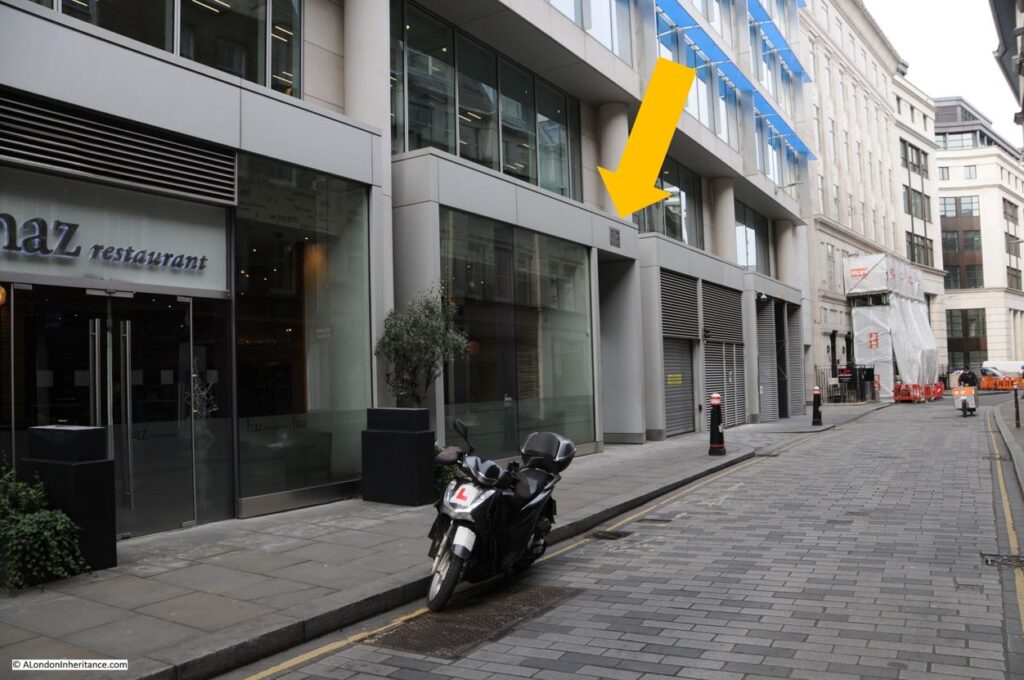
Recording that St. Leonard’s, another of the churches not rebuilt following the Great Fire, was located here:
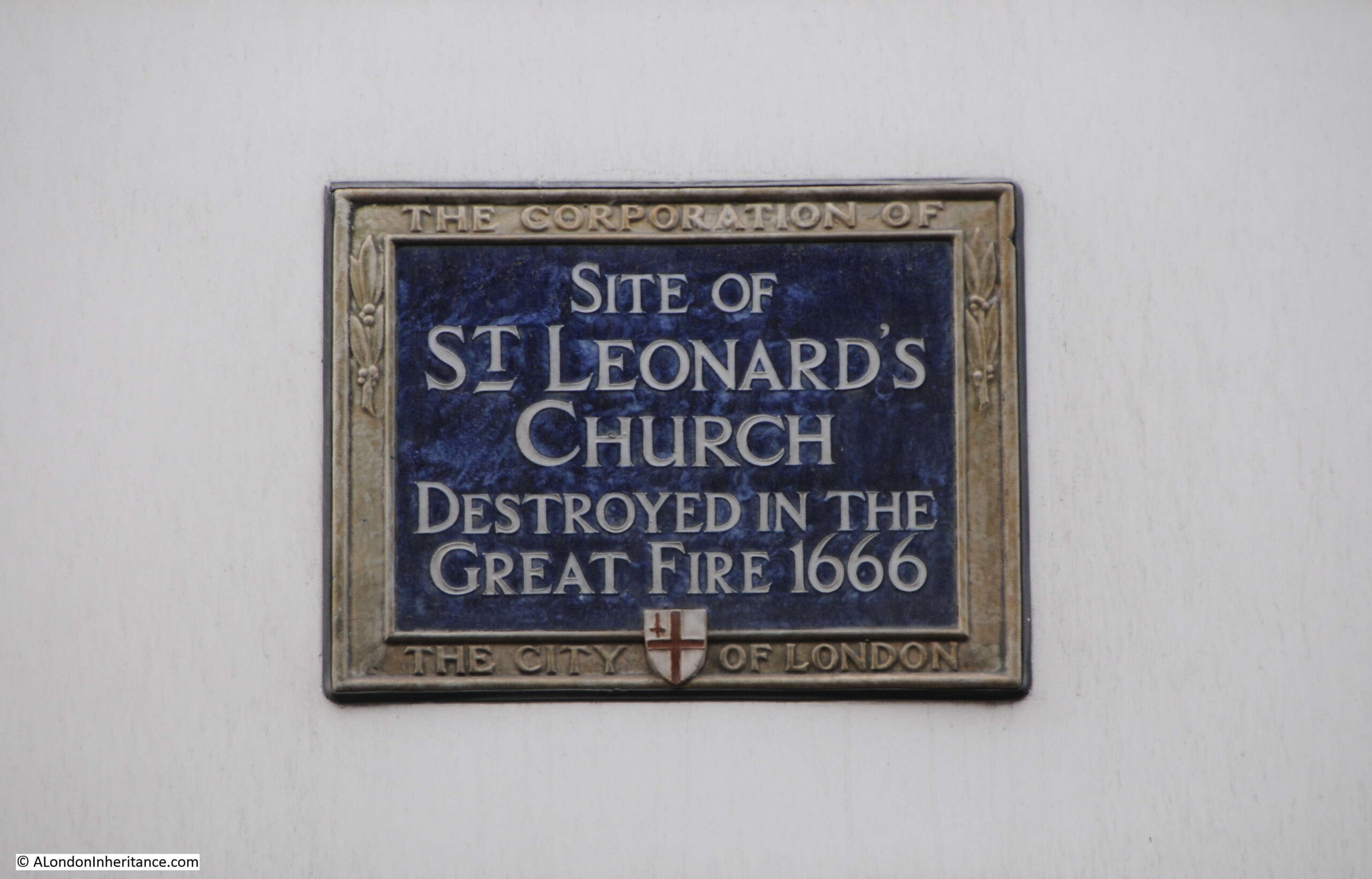
Again, the book “London Churches Before The Great Fire” is my main source for information on this long lost church, and the book records that:
“St. Leonard’s, Foster Lane, formerly stood on the west side of that street, being a small parish church designed for people of St. Martin-le-Grand, and founded by the dean and canons of the priory on the thirteenth century. Outside of the church was a monument to John Brokeitwell, one of the founders and new builders of the church.
Francis Quarles, the somewhat eccentric poet, well known as the author of The Emblems was buried here in 1644.
The first rector of the church was William de Tyryngton who died in 1325. William Ward was rector in 1636, and was censured by a committee of Parliament for innovations. He was forced to fly, plundered, and at last died of want.
In 1636 the yearly income, including a house, was £139. the church was burnt in the Great Fire and not rebuilt, the parish being united to that of Christchurch.”
Francis Quarles seems to have been an interesting character. He took the Royalist side during the Civil War, and published several pamphlets in support of the Royalist cause, but he is one of those research rabbit holes that I must avoid going down so I can get a weekly post completed.
All that remains now of the church is the City of London blue plaque.
Haberdashers Hall
On the corner of Staining and Gresham Streets is a plaque:

Recording that this was the site of the Haberdashers Hall from 1458 to 1996:
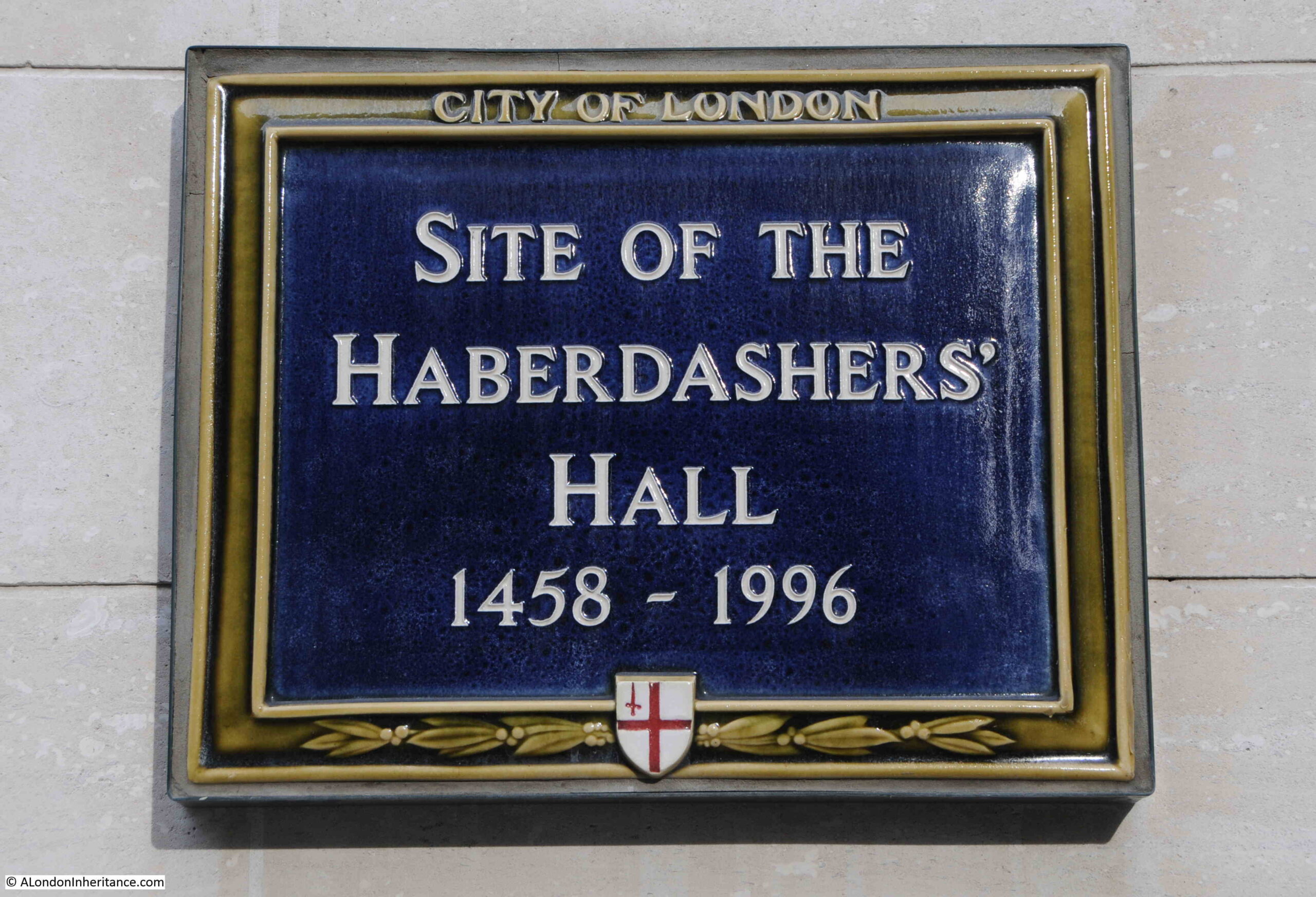
The Worshipful Company of Haberdashers dates back to the 14th century when those engaged in the trade of selling items such as ribbons, pins, gloves, toys and purses formed a Company. They were joined by the Hatmakers in 1502.
The name Haberdasher may have an origin with the name of the coarse, thick cloth used under a suit of armour. In two lists of custom dues on cloths and furs coming into London during the reign of Edward I (1272 to 1307), the word “hapertas” appears in one list and “haberdassherie” appears in the second list. Given that they both appear in lists of cloths and furs, and they are similar words, they may have the same meaning.
The word “hapertas” was the word used for the cloth used under armour, so this may be the origin of the word haberdashery, but, at this distance of time it is difficult to be sure.
The corner location of the plaque had been the site of the Haberdashers Hall for over 500 years. The first hall was built in 1458, but was destroyed in 1666 during the Great Fire. It was followed a couple of years later by a second hall which was built on the same site.
This second hall lasted until 1940, when it was destroyed during wartime bombing of the City.
A third hall was built in 1956, but was not a standalone hall, rather it was part of a larger office development. This hall would only last for 40 years, as in 1996 the whole site was redeveloped as office space. The Haberdashers moved to a new hall in West Smithfield, which they still occupy today.
The following print shows the Haberdashers Hall in 1855:
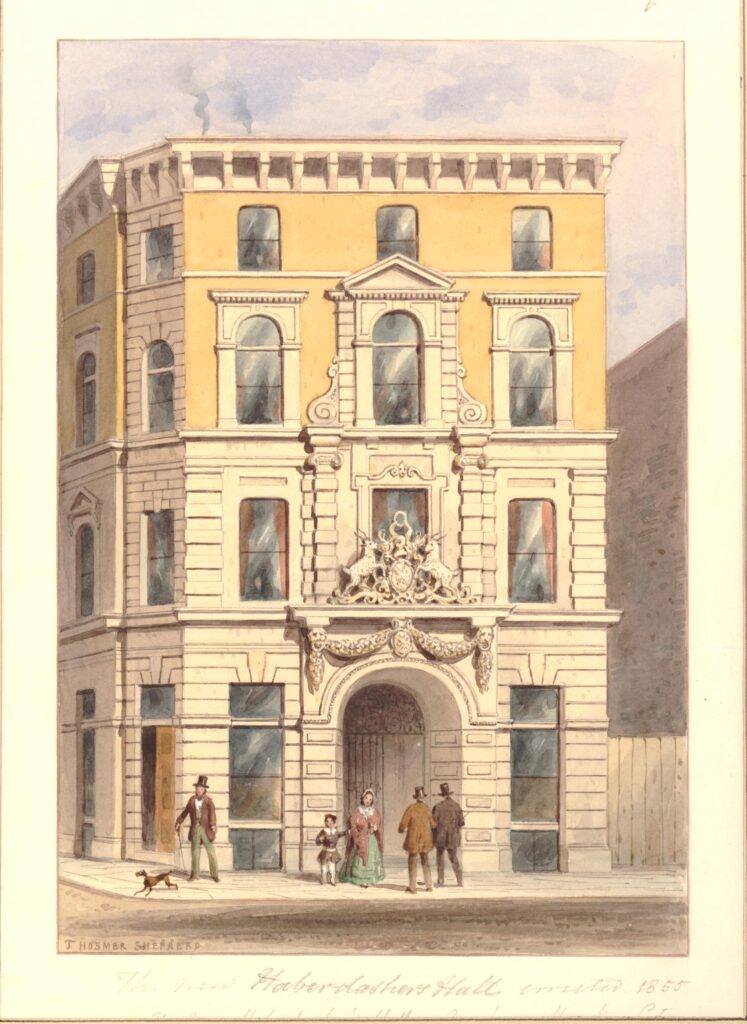
A bit difficult to see, but the arms of the Haberdashers can be seen above the door in the above print. These arms can still be seen today at the site. If you look to the left of the blue plaque, the following arms are set on the wall:

I assume this is a boundary or ownership marking, implying that whilst the Haberdashers have moved location, they still own the property on the site of their old hall.
The Aldermanbury Conduit
On the wall in Love Lane alongside the location of the church of St. Mary Aldermanbury, is a plaque:
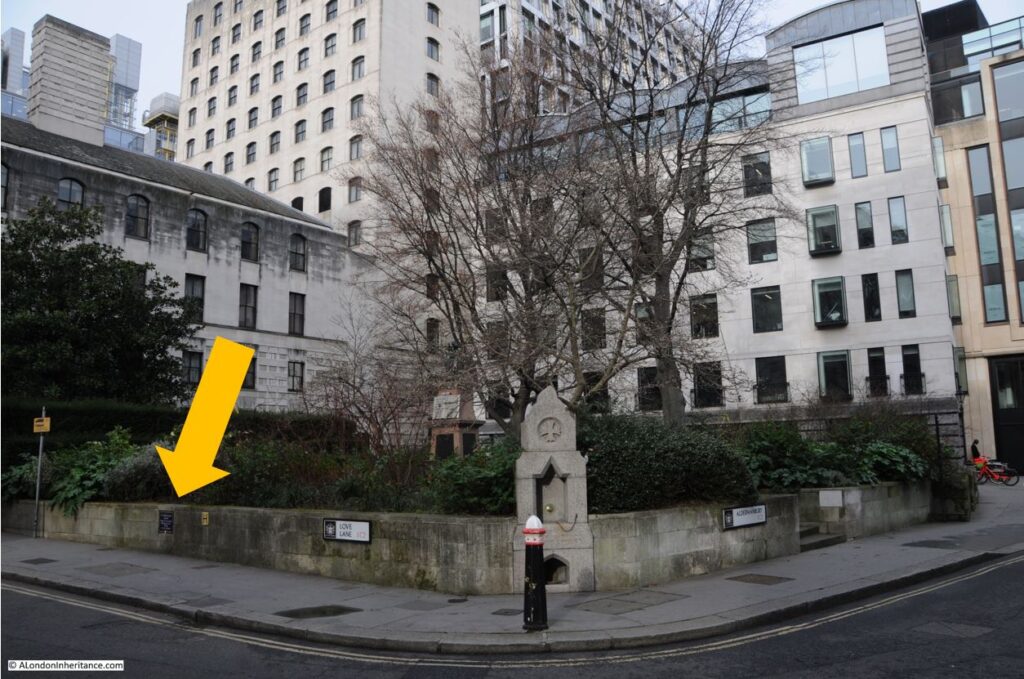
Which records that the Aldermanbury Conduit stood in this street providing free water from 1471 to the 18th century:
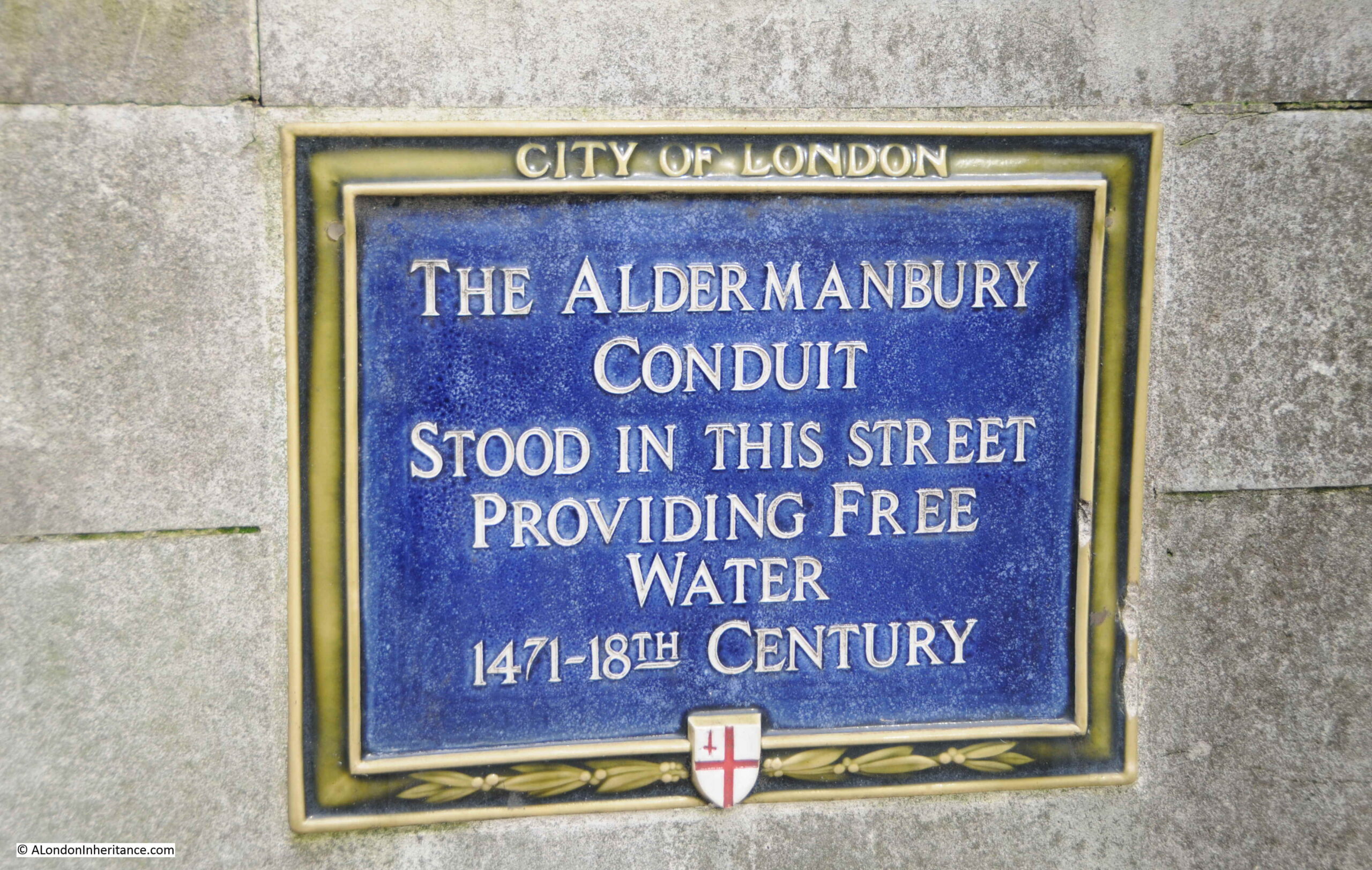
Whilst the plaque is accurate for the presumed opening date of the conduit, it just lists the 18th century as the end of the conduit. I wondered if there was an illustration of the conduit in prints of the church. The earliest print I found was from 1750 and no sign of the conduit.
Rocque’s map of 1746 has a couple of squiggles were the conduit should be, but I think these are trees, so the conduit probably disappeared in the early 18th century.
What was a conduit? It was basically a structure where water was stored and dispensed to people in need of water. Water could be fed into the conduit through pipes, a stream or spring, or being carried in buckets from another source.
I have photographed two conduits, so whilst I have no idea of what the Aldermanbury Conduit looked like, these others provide an example of their basic form and function.
The first is a possibly 14th century conduit at New River Head in Clerkenwell. The following photo shows the conduit to the rear of the site of the old Metropolitan Water Board building:
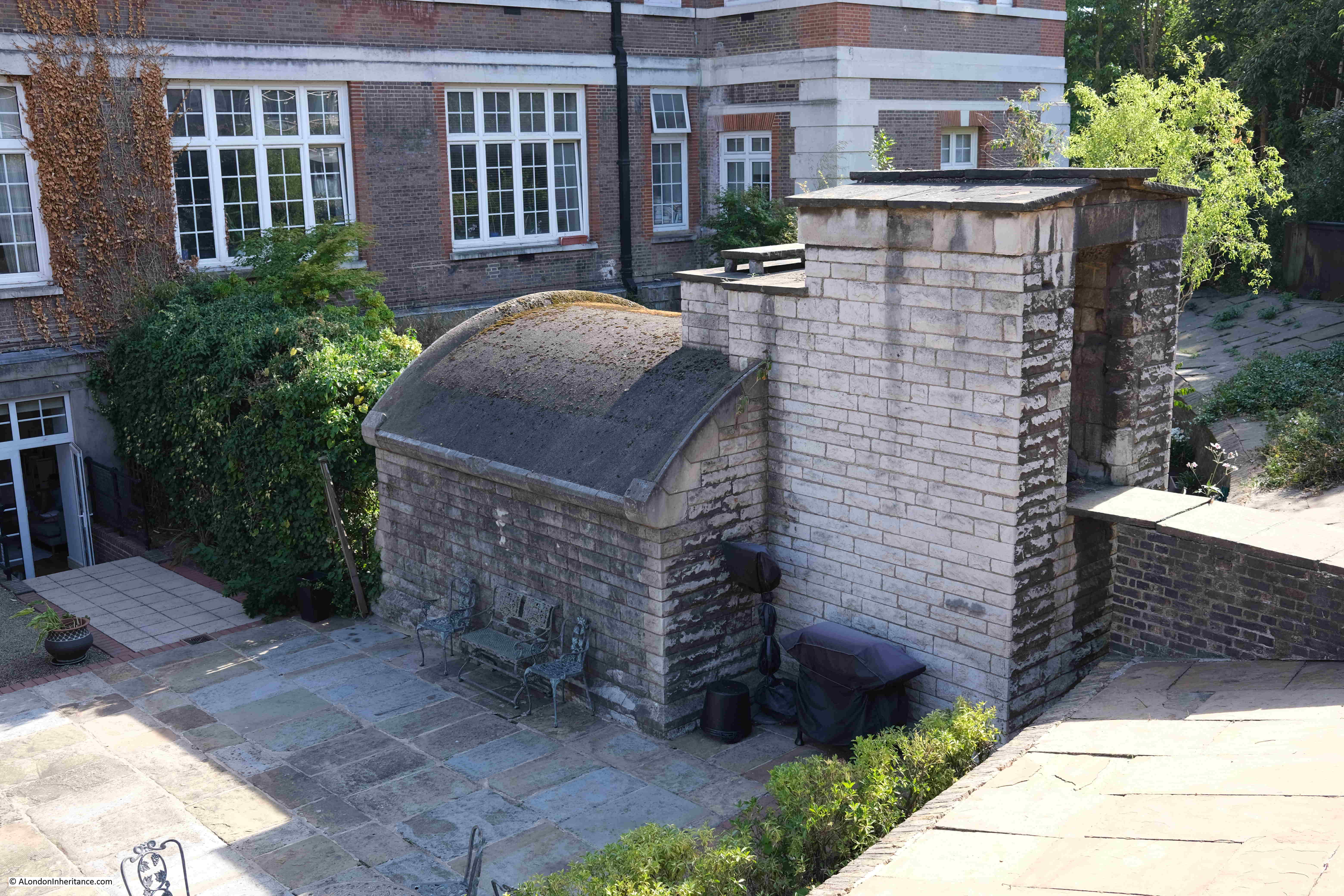
It is not in its original location, as it was at located next to Queen Square in Bloomsbury, and moved when the Imperial Hotel in Russell Square was being extended to the rear.
The following is typical of newspaper reports of the discovery:
“The extension scheme of the Imperial Hotel in Russell Square includes the acquisition of Chalfort House, and in the garden of the latter there is a very interesting old relic of the past. It is the conduit head which leads down to a small reservoir from which, since the thirteenth century, the water supply has been conveyed through a pipe to the Grey Friars, and later to Christ’s Hospital, more than a mile away.
The masonry is still entire, but owing to changes of levels is now all several feet below ground. It has been known both as the Chimney Conduit and the Devil’s Conduit. there is also a brick-built tunnel which leads to a well several yards away.
Dr. Philip Norman some time ago made some very interesting discoveries regarding the ancient water supply of the old monastic house, and it would be a pity if this old conduit would be destroyed. If it could be in some way preserved it would certainly become an attractive showplace for American visitors.”
The conduit was rescued by Charles Fitzroy Doll, the architect of the Imperial Hotel which was built between 1905 and 1911 (the predecessor of the current Imperial Hotel). The Chimney Conduit name is rather descriptive of the appearance of the conduit, however I cannot find a confirmed source for the Devil’s Conduit name.
View from the entrance of the conduit showing the steps leading down into the space that once stored water:
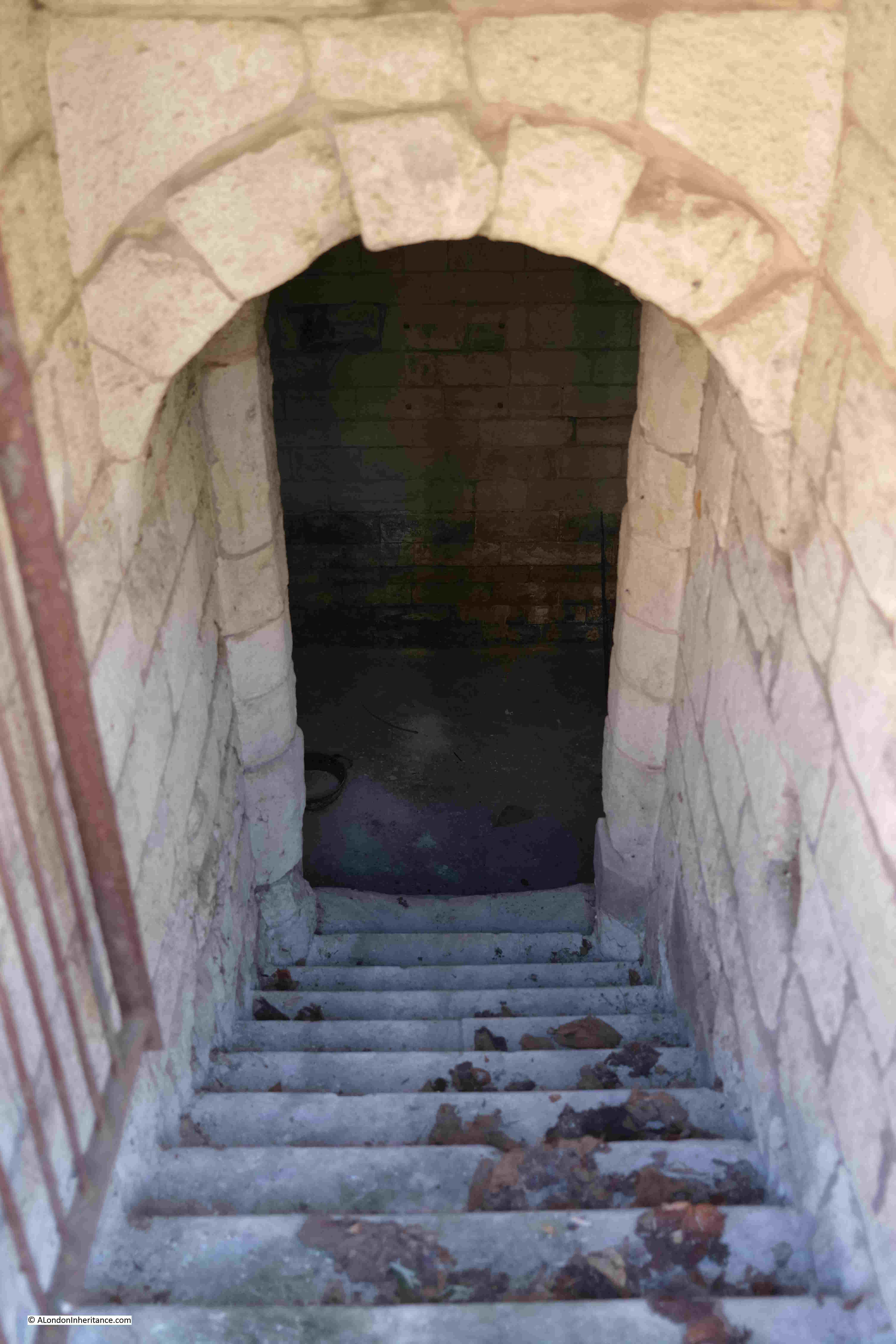
Inside the conduit, showing how the walls arched to form a continuous wall / roof to the structure:
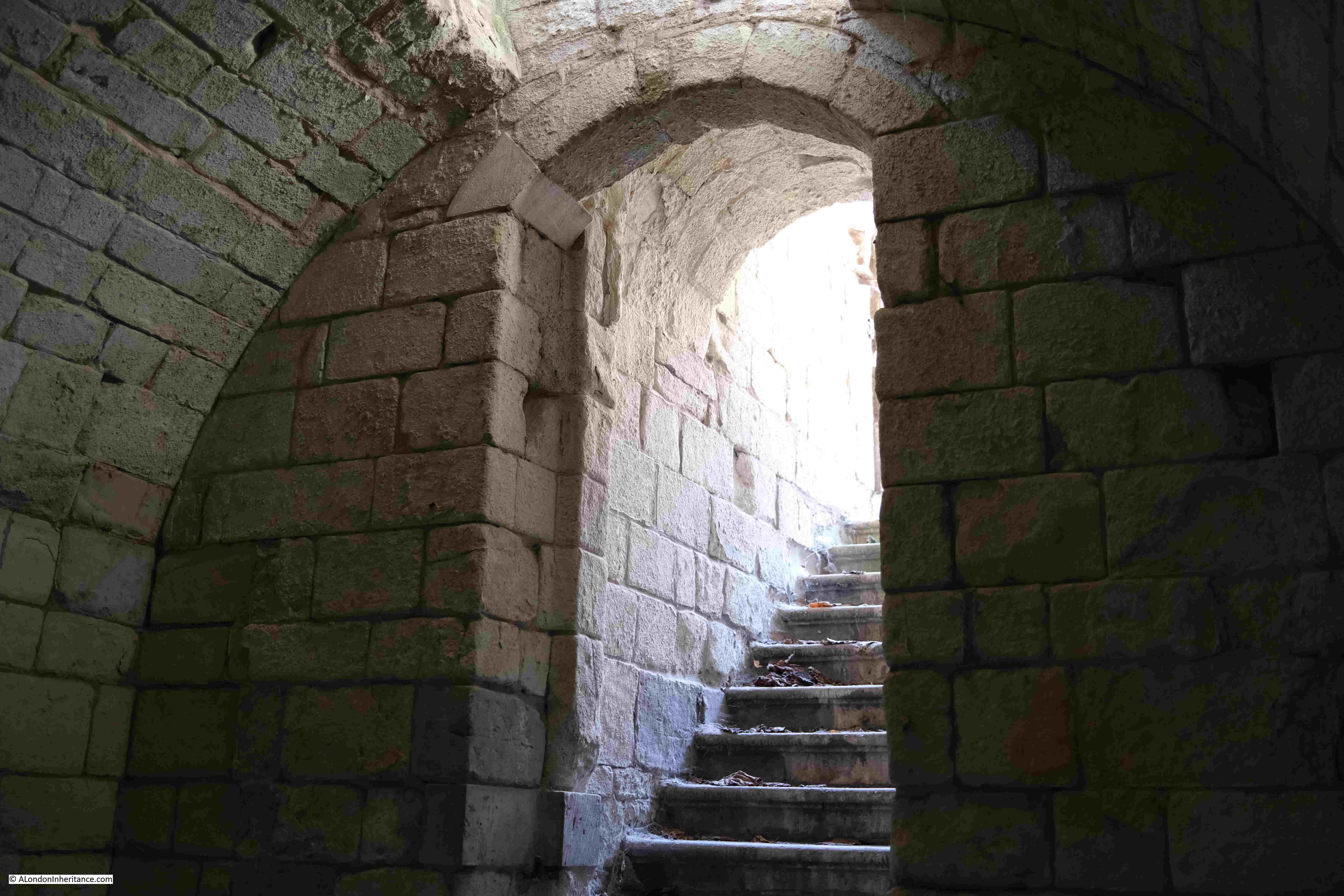
I found another conduit last year in Grantham as I was following the sites of the Eleanor Crosses.
This conduit also has its origins with the Grey Friars who purchased the land around a spring outside of Grantham and piped the water to their property.
In 1597 the water supply was extended by pipe to the conduit in the market place. The conduit and pipeline was constructed by the Corporation of Grantham.
The conduit has seen many repairs since it was built, in 1927 the roof was replaced, along with three of the distinctive pinnacles.
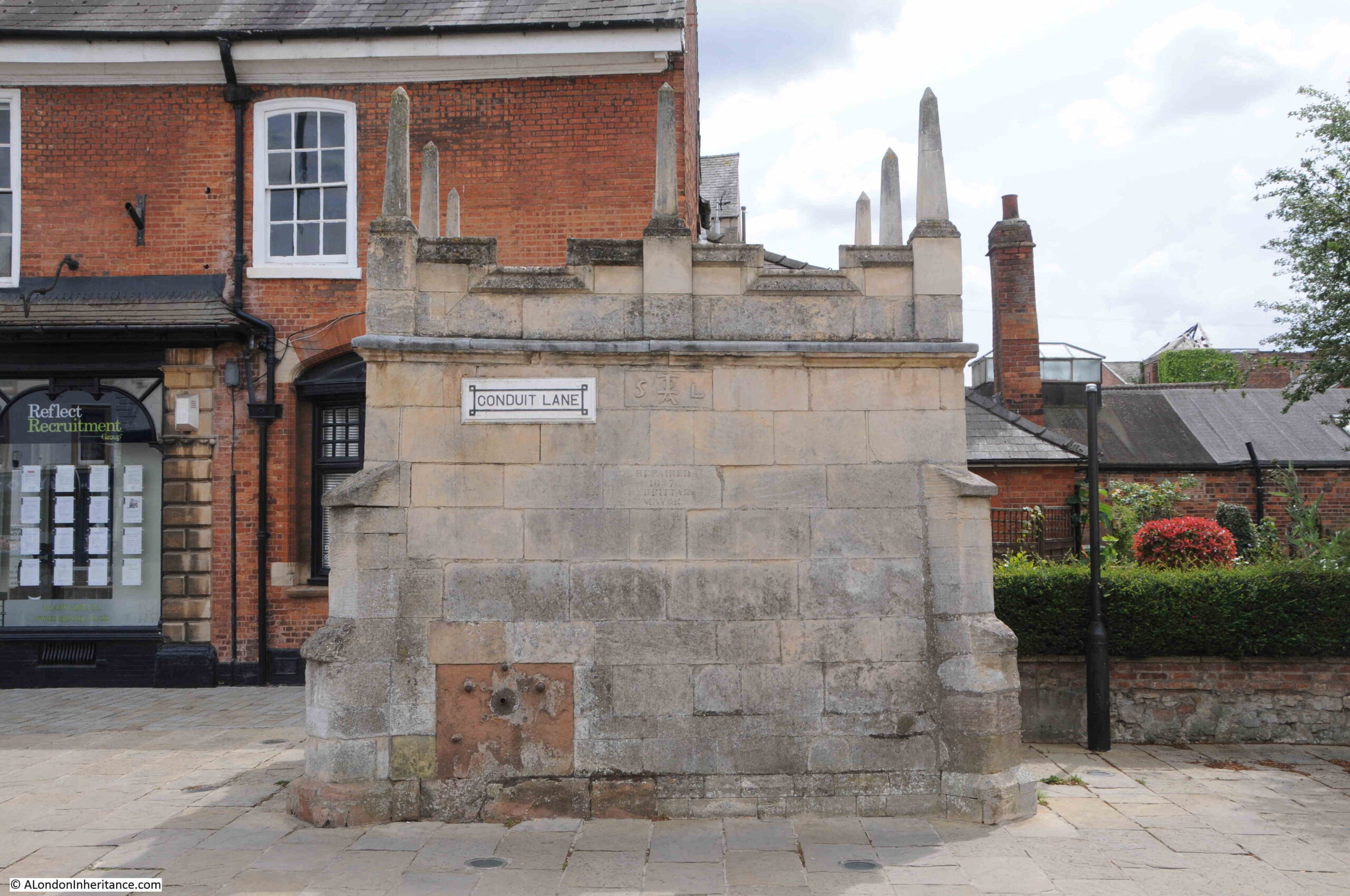
I have no idea whether the Aldermanbury Conduit looked like either of the above two examples, however there cannot have been too many variations as it was basically a stone box used to store water ready for distribution, either by pipe, or at the conduit.
Now the site is marked by the blue plaque.
The Daily Courant – London’s First Daily Newspaper
Where Ludgate Hill meets Ludgate Circus is a blue, City of London plaque:
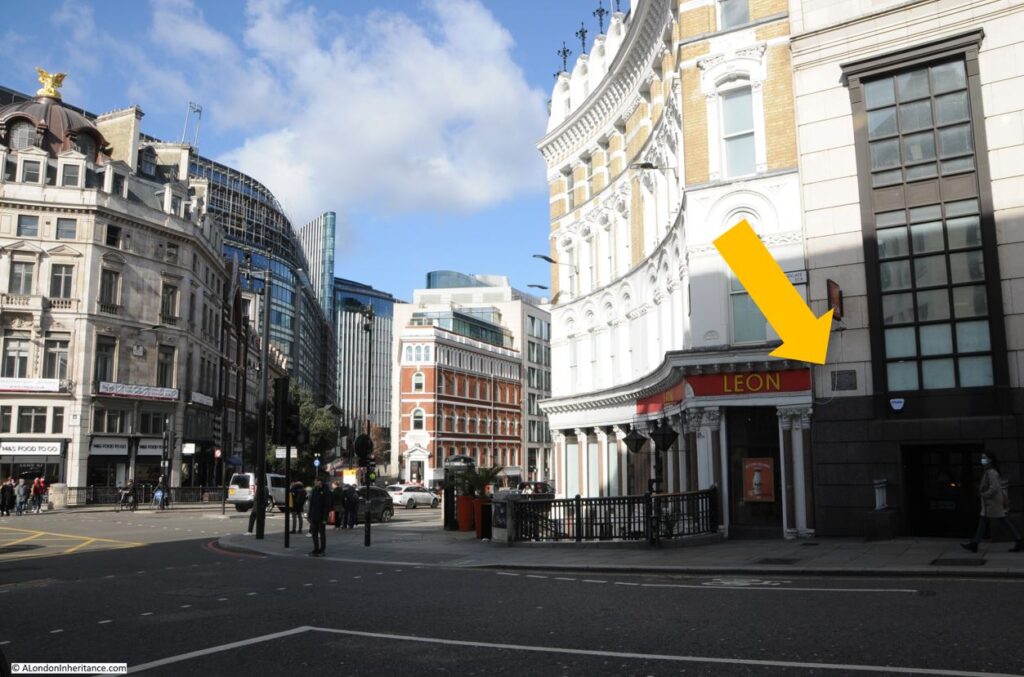
Recording that in a house near this site was published in 1702 the Daily Courant. The first daily newspaper (except Sunday’s) in London:
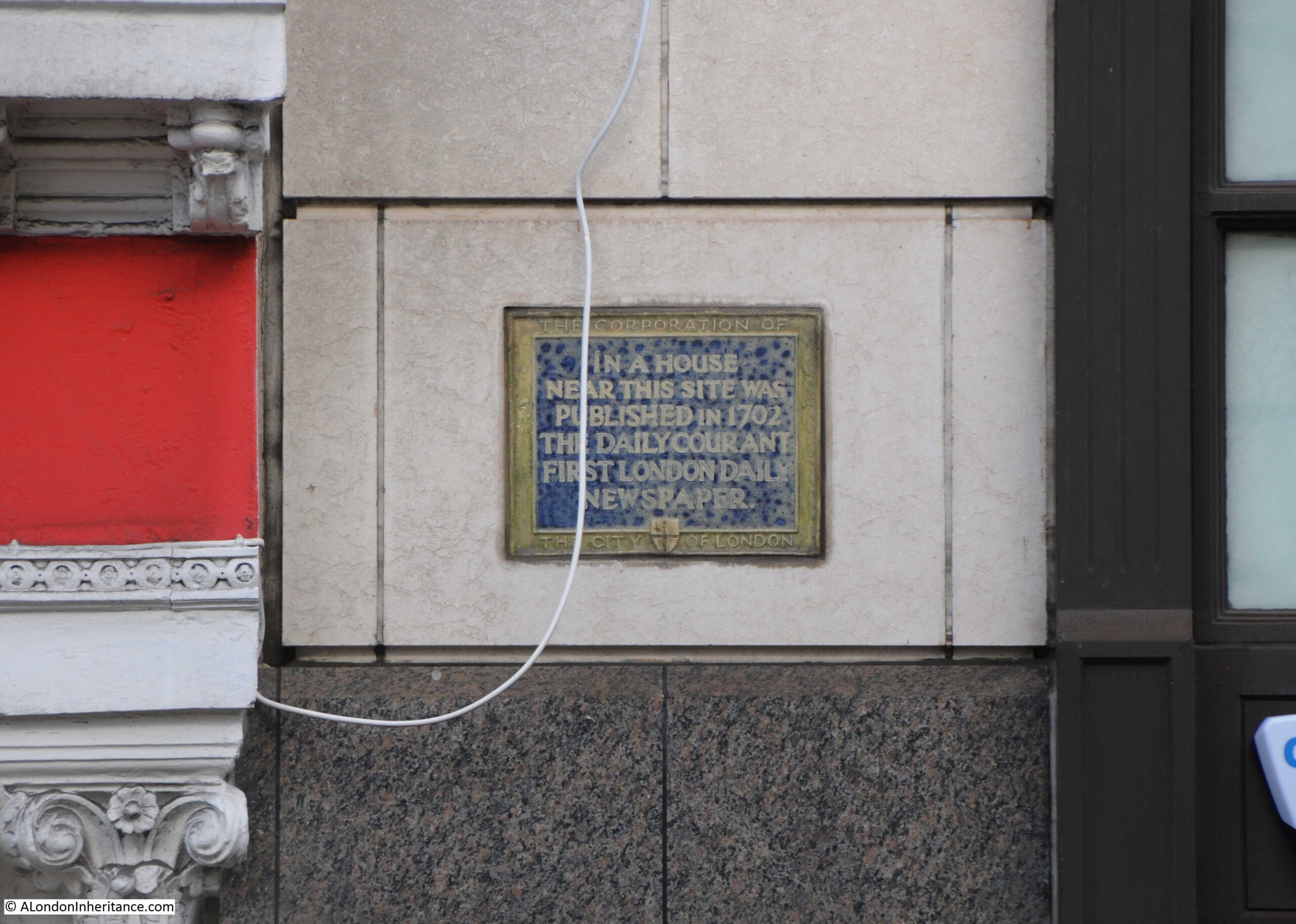
The following is from a number of newspapers in January 1870, reporting on the Daily Courant:
“The first daily paper published in England was the Daily Courant, which was commenced on the 11th of March, 1702. It was published by E. Mallet, against the Ditch at Fleet-bridge, not far, we may presume, from the present head-quarters of the Times or Daily Telegraph. It was a single page of two columns; and unlike the papers of our own time, it professed to give merely the home and foreign news, the editor assuring his readers that he would add no comment of his own, ‘supposing other people to have sense enough to make reflections for themselves’. In 1785 the Daily Courant appears to have been absorbed into the Daily Gazetteer.”
A fascinating description of the location as being “against the Ditch at Fleet-bridge” recording that in 1702, the Fleet was still uncovered at this point where today New Bridge Street meets Farringdon Street, that there was a bridge to cross over to Fleet Street, and that it was very much a polluted ditch.
The article mentions that the paper was published by E. Mallet, this was Elizabeth Mallet who was already successful in the book publishing trade when she started the Courant. She seems to have used the initial E rather then her full first name due to the lack of women in the trade , and possible bias against the Courant if it was known that a woman was the publisher.
The sentence that the “the editor assuring his readers that he would add no comment of his own” is interesting. 18th century newspapers were based on written reports, letters, copy from other newspapers etc. Papers such as the Daily Courant did not have a network of reporters producing copy for the paper to publish.
The Daily Courant simply published the reports and letters they had received, and left it up to the reader to judge the truth, implications and wider context of the report. The paper did try and get more than a single source and often published reports from two or three different foreign newspapers about a single place or event.
The paper also published the following advertisement in the first few issues to reinforce the point:
“It will be found from the Foreign Prints which from time to time, as Occasion offers, will be mentioned in this Paper, that the Author has taken Care to be duly furnished with all that comes from Abroad in any Language. And for an Assurance that he will not under pretence of having Private Intelligence, impose any Additions of feigned Circumstances to an Action, but give his Extracts fairly and Impartially; at the beginning of each Article he will quote the Foreign paper from whence it is taken, that the Public, seeing from what Country a piece of News comes with the Allowance of that Government, may be better able to Judge of the Credibility and Fairness of the Relation: nor will he take upon him to give any Comments or Conjectures of his own, but will relate only Matter of Fact; supposing other People to have Sense enough to make Reflections for themselves.”
This approach did lead to problems for the Daily Courant, when in 1705 it reported on a great naval disaster for allies of Queen Anne. A report which turned out to be false.
The Daily Courant defended itself by stating that it had only been reporting what it had received in a “Paris Letter”, and it had assumed that its readers would not give much credibility to the report as it had come from a pro-French source.
The first issue of the Daily Courant:

Image attribution: Edward Mallet from rooms above the White Hart pub in Fleet Street, Public domain, via Wikimedia Commons
I found the above image on Wikipedia and copied the attribution required where the image is used, however this attribution states Edward rather than Elizabeth Mallet, and the majority of sources regarding the Daily Courant, including academic studies do refer to an Elizabeth Mallet.
18th century newspapers are fascinating, and they started to flourish in the years following the Daily Courant’s publication in 1702.
They became broadsheets full of content of what was happening across the country, across Europe and the wider world, and comparing with newspapers today (and much of the media in general), readers in the 18th century were much better informed about world news than a 21st century reader.
However, in the 18th century, readership was confined only to those who could afford a newspaper and could read, and much of the content was simply repeating accounts that had been received. Many reports begin with “We hear that” or “Letters received from XXXXX report that”, so much like the Daily Courant, what was written needed to be tested, and could not always be assumed to be the truth.
Global content also reflected the Empire and Britain’s trading links with much of the world, along with the wars and disputes that the country seems to have been involved in for much of the time.
It is interesting that the defence given by the Daily Courant in 1705, that readers should be aware of the source before establishing the credibility of a news report should still apply three hundred years later with much of today’s news reporting and social media.
That is six more plaques explored, and which again show the fascinating stories that can be uncovered by these simple plaques that can be found across the walls of the City of London.

Another Sunday morning and another wonderful post from you. Today’s post is especially interesting as co-incidentally I have been researching The Daily Courant for my Instagram account @behindtheplaques which you might be interested in. My posts are only snap shots compared to yours as the format is limited. I won’t bother with the Courant one now. I have over 1200 plaque shots (mostly in and around London) but others from across the UK and abroad so many more posts to come.
Please keep posting as they are a great way to spend a Sunday morning finding out the background to so many places and people
I have my great grandmother’s bible and on the inside cover she has written her address as follows:
St Andrews Hill, Doctors Commons, and she has dated it May 1850. The building number she actually lived at on the Hill was infact ‘two and one half’, but i am unable to type fractions on my computer.
I have an 1851 Exhibition Guide to London, and Doctors Commons is included in a suggested tour of the Metropolis.
Charles Dickens mentions Doctors Commons in David Copperfield and Sketches of Boz and is quite scathing at some of its workings.
The Agas map shows the conduit and it looks rather jolly and crenellated, like the one in Grantham. I would very much like to have seen all the conduits in the city, especially when they were running with wine. As for the Daily Courant – hands-down the best name for a newspaper ever.
That’s a great account of the Daily Courant and its news values. It wasn’t limited to those who could read, though – it was common for newspapers to be read to be read aloud in public and private spaces. Also, you didn’t necessarily have to buy a copy of a newspaper, as they were often made available in coffee houses, so you just needed to pay for for your drink. Commentary on the news would be provided by those seated at the tables where newspapers (and official notices) were laid out. All of which sounds rather contemporary, if you replace coffee house conversation with Twitter.
Fascinating account of plaques which are easily overlooked. I am still unsure as to where the “commons” comes from. Common Law ? ( But some of it is Ecclesiastical ) or the fact that the lawyers shared the space in common ? I would be grateful for clarification. Thanks in advance.
Have you come across Musical Monuments by J M Popkin? There are quite a few blue plaques mentioned of musicians, composerz etc.
Superb edition
Thanks
Woke up yesterday to your weekly Sunday post which I read during the morning. Quite co-incidentally I had been researching The Daily Courant for my Instagram account @behindtheplaques but I won’t bother now as you have as usual done such a good job detailing the background to this and all the other content in the latest post. My posts are restricted to the format of 2200 characters which limits what I can write.
I have a library of over 1200 plaques from all over the UK and other countries but the majority are in London and nearly all my posts are about people.
I look forward to reading your next posts and thanks for what you have been doing.
Has the King Lud gone?
Thanks once more for another very interesting post.
I always look forward to reading your Posts. Have learned so much. Very informative.
Absolutely fascinating – but how can one have access to the full text beyond the computer screen?
Kindest regards and many thanks for your meticulous research.
Ericde Bellaigue
Is it fair to assume that graves located in churches destroyed by the Great Fire are still there, under modern buildings? Has any attempt ever been made to determine whose graves they may be?
Thanks